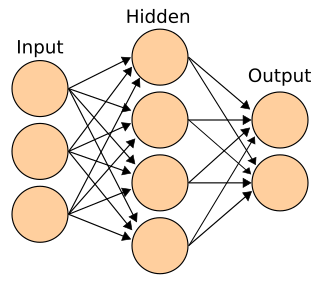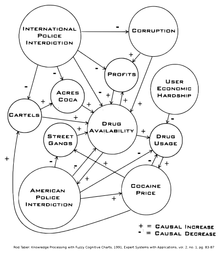Fuzzy logic is a form of many-valued logic in which the truth value of variables may be any real number between 0 and 1. It is employed to handle the concept of partial truth, where the truth value may range between completely true and completely false. By contrast, in Boolean logic, the truth values of variables may only be the integer values 0 or 1.
Reinforcement learning (RL) is an interdisciplinary area of machine learning and optimal control concerned with how an intelligent agent ought to take actions in a dynamic environment in order to maximize the cumulative reward. Reinforcement learning is one of three basic machine learning paradigms, alongside supervised learning and unsupervised learning.

In artificial intelligence and philosophy, case-based reasoning (CBR), broadly construed, is the process of solving new problems based on the solutions of similar past problems.

Connectionism is the name of an approach to the study of human mental processes and cognition that utilizes mathematical models known as connectionist networks or artificial neural networks. Connectionism has had many 'waves' since its beginnings.

A cognitive map is a type of mental representation which serves an individual to acquire, code, store, recall, and decode information about the relative locations and attributes of phenomena in their everyday or metaphorical spatial environment. The concept was introduced by Edward Tolman in 1948. He tried to explain the behavior of rats that appeared to learn the spatial layout of a maze, and subsequently the concept was applied to other animals, including humans. The term was later generalized by some researchers, especially in the field of operations research, to refer to a kind of semantic network representing an individual's personal knowledge or schemas.
The expression computational intelligence (CI) usually refers to the ability of a computer to learn a specific task from data or experimental observation. Even though it is commonly considered a synonym of soft computing, there is still no commonly accepted definition of computational intelligence.
Bart Andrew Kosko is a writer and professor of electrical engineering and law at the University of Southern California (USC). He is a researcher and popularizer of fuzzy logic, neural networks, and noise, and the author of several trade books and textbooks on these and related subjects of machine intelligence. He was awarded the 2022 Donald O. Hebb Award for neural learning by the International Neural Network Society.

In intelligence and artificial intelligence, an intelligent agent (IA) is an agent acting in an intelligent manner. It perceives its environment, takes actions autonomously in order to achieve goals, and may improve its performance with learning or acquiring knowledge. An intelligent agent may be simple or complex: A thermostat or other control system is considered an example of an intelligent agent, as is a human being, as is any system that meets the definition, such as a firm, a state, or a biome.
In data analysis, anomaly detection is generally understood to be the identification of rare items, events or observations which deviate significantly from the majority of the data and do not conform to a well defined notion of normal behavior. Such examples may arouse suspicions of being generated by a different mechanism, or appear inconsistent with the remainder of that set of data.
Computational neurogenetic modeling (CNGM) is concerned with the study and development of dynamic neuronal models for modeling brain functions with respect to genes and dynamic interactions between genes. These include neural network models and their integration with gene network models. This area brings together knowledge from various scientific disciplines, such as computer and information science, neuroscience and cognitive science, genetics and molecular biology, as well as engineering.

Brian R. Gaines is a British scientist, engineer, and Professor Emeritus at the University of Calgary.
An incremental decision tree algorithm is an online machine learning algorithm that outputs a decision tree. Many decision tree methods, such as C4.5, construct a tree using a complete dataset. Incremental decision tree methods allow an existing tree to be updated using only new individual data instances, without having to re-process past instances. This may be useful in situations where the entire dataset is not available when the tree is updated, the original data set is too large to process or the characteristics of the data change over time.
Proaftn is a fuzzy classification method that belongs to the class of supervised learning algorithms. The acronym Proaftn stands for:, which means in English: Fuzzy Assignment Procedure for Nominal Sorting.
Medical image computing (MIC) is an interdisciplinary field at the intersection of computer science, information engineering, electrical engineering, physics, mathematics and medicine. This field develops computational and mathematical methods for solving problems pertaining to medical images and their use for biomedical research and clinical care.
This glossary of artificial intelligence is a list of definitions of terms and concepts relevant to the study of artificial intelligence, its sub-disciplines, and related fields. Related glossaries include Glossary of computer science, Glossary of robotics, and Glossary of machine vision.
In computer science, incremental learning is a method of machine learning in which input data is continuously used to extend the existing model's knowledge i.e. to further train the model. It represents a dynamic technique of supervised learning and unsupervised learning that can be applied when training data becomes available gradually over time or its size is out of system memory limits. Algorithms that can facilitate incremental learning are known as incremental machine learning algorithms.
Explainable AI (XAI), often overlapping with Interpretable AI, or Explainable Machine Learning (XML), either refers to an artificial intelligence (AI) system over which it is possible for humans to retain intellectual oversight, or refers to the methods to achieve this. The main focus is usually on the reasoning behind the decisions or predictions made by the AI which are made more understandable and transparent. XAI counters the "black box" tendency of machine learning, where even the AI's designers cannot explain why it arrived at a specific decision.
Soft computing is an umbrella term used to describe types of algorithms that produce approximate solutions to unsolvable high-level problems in computer science. Typically, traditional hard-computing algorithms heavily rely on concrete data and mathematical models to produce solutions to problems. Soft computing was coined in the late 20th century. During this period, revolutionary research in three fields greatly impacted soft computing. Fuzzy logic is a computational paradigm that entertains the uncertainties in data by using levels of truth rather than rigid 0s and 1s in binary. Next, neural networks which are computational models influenced by human brain functions. Finally, evolutionary computation is a term to describe groups of algorithm that mimic natural processes such as evolution and natural selection.
A causal map can be defined as a network consisting of links or arcs between nodes or factors, such that a link between C and E means, in some sense, that someone believes or claims C has or had some causal influence on E.
Javier Andreu-Perez is a British computer scientist and a Senior Lecturer and Chair in Smart Health Technologies at the University of Essex. He is also associate editor-in-chief of Neurocomputing for the area of Deep Learning and Machine Learning. Andreu-Perez research is mainly focused on Human-Centered Artificial Intelligence (HCAI). He also chairs a interdisciplinary lab in this area, HCAI-Essex.




